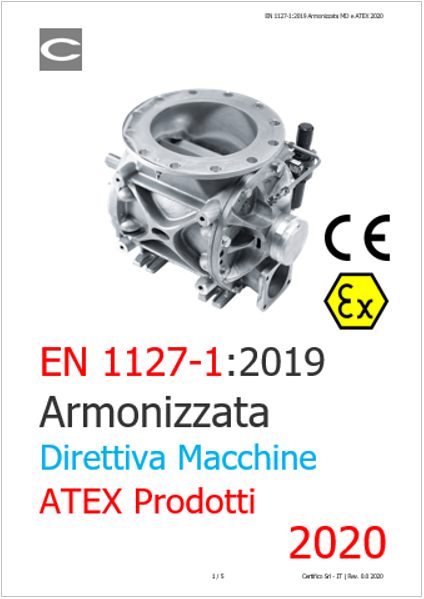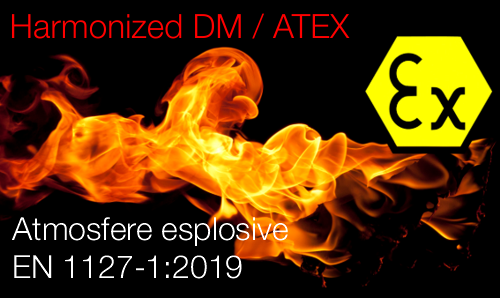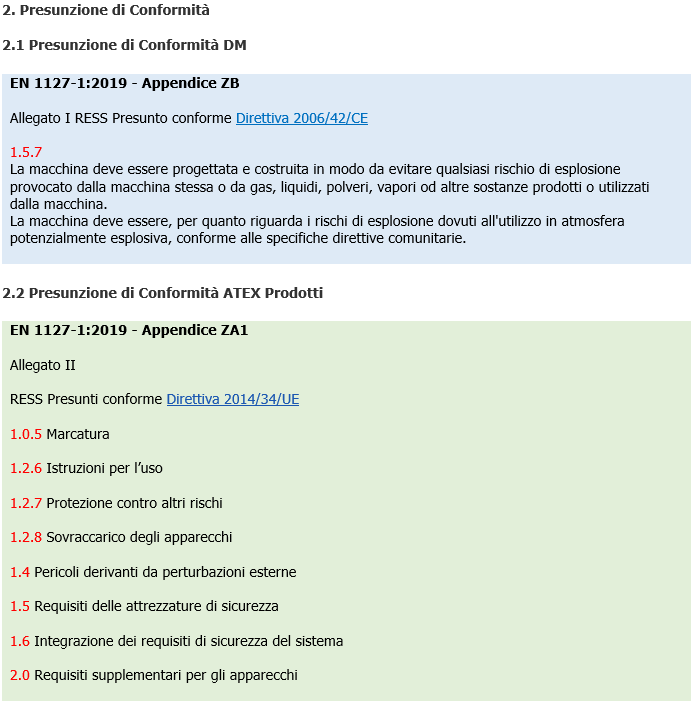EN 1127-1:2019 Atmosfere esplosive: Armonizzata MD e ATEX 2020
| Appunti Normazione | ||
| 10 Maggio 2025 | ||
| Salve Visitatore | ||
EN 1127-1:2019 | Atmosfere esplosive: armonizzata MD e ATEX ID 9515 | 14.04.2020 Documenti/note sulla EN 1127-1:2019 "ATEX Concetti fondamentali e metodologia", armonizzata, a Febbraio 2020 per la Direttiva 2014/34/UE (ATEX Prodotti) ed ad Aprile 2020 per la Direttiva 2006/42/CE (macchine) tipo B. - Documento note Armonizzazione e Presunzione Conformità DM e LVD UNI EN 1127-1:2019 Atmosfere esplosive - Prevenzione dell'esplosione e protezione contro l'esplosione - Parte 1: Concetti fondamentali e metodologia Data entrata in vigore: 14 novembre 2019 La norma specifica i metodi per l'identificazione e la valutazione delle situazioni pericolose che conducono all'esplosione e le misure di progettazione e costruzione adeguate alla sicurezza richiesta. Recepisce: EN 1127-1:2019 1. Armonizzazione 1.1 Armonizzazione MD La UNI EN 1127-1:2019 con la Decisione di esecuzione (UE) 2020/480 (GU L 102/6 del 02.04.2020), entra in regime di armonizzazione per la Direttiva 2006/42/CE (macchine) a partire dalla data del 02 Aprile 2020. La norma sostituita, EN 1127-1:2011, è ritirata dal 02 Ottobre 2021 (cessazione Presunzione di Conformità). 1.2 Timeline "Presunzione di Conformità" Macchine La timeline di "Presunzione di Conformità" alla Direttiva macchine 2006/42/CE della EN 1127-1:2019 e EN 1127-1:2011 è schematizzata come: 1.3 Armonizzazione ATEX Prodotti La UNI EN 1127-1:2019 con la Decisione di esecuzione (UE) 2020/260 (GU L 54/31 del 26.02.2020) è entrata in regime di armonizzata per la Direttiva 2014/34/UE (ATEX Prodotti) a partire dalla data del 26 Febbraio 2020. La norma sostituita, EN 1127-1:2011, è ritirata dal 01 Febbraio 2022 (cessazione Presunzione di Conformità). 1.3 Armonizzazione ATEX Prodotti EN 1127-1:2019 Explosive atmospheres - Explosion prevention and protection - Part 1: Basic concepts and methodology This document specifies methods for the identification and assessment of hazardous situations leading to explosion and the design and construction measures appropriate for the required safety. This is achieved by: — risk assessment; — risk reduction. The safety of equipment, protective systems and components can be achieved by eliminating hazards and/or limiting the risk, i.e. by: a) appropriate design (without using safeguarding); b) safeguarding; c) information for use; d) any other preventive measures. Measures in accordance with a) (prevention) and b) (protection) against explosions are dealt with in Clause 6, measures according to c) against explosions are dealt with in Clause 7. Measures in accordance with d) are not specified in this document. They are dealt with in EN ISO 12100:2010, Clause 6. The preventive and protective measures described in this document will not provide the required level of safety unless the equipment, protective systems and components are operated within their intended use and are installed and maintained according to the relevant codes of practice or requirements. This document specifies general design and construction methods to help designers and manufacturers in achieving explosion safety in the design of equipment, protective systems and components. This document is applicable to any equipment, protective systems and components intended to be used in potentially explosive atmospheres, under atmospheric conditions. These atmospheres can arise from flammable/combustible substances processed, used or released by the equipment, protective systems and components or from materials in the vicinity of the equipment, protective systems and components and/or from the materials of construction of the equipment, protective systems and components. This document is applicable to equipment, protective systems and components at all stages of its use. This document is only applicable to equipment group II which is intended for use in other places than underground parts of mines and those parts of surface installations of such mines endangered by firedamp and/or combustible dust. This document is not applicable to: 1) medical devices intended for use in a medical environment; 2) equipment, protective systems and components where the explosion hazard results exclusively from the presence of explosive substances or unstable chemical substances; 3) equipment, protective systems and components where the explosion can occur by reaction of substances with other oxidizers than atmospheric oxygen or by other hazardous reactions or by other than atmospheric conditions; 4) equipment intended for use in domestic and non-commercial environments where potentially explosive atmospheres may only rarely be created, solely as a result of the accidental leakage of fuel gas; 5) personal protective equipment covered by Regulation (EU) 2016/425; 6) seagoing vessels and mobile offshore units together with equipment on board such vessels or units; 7) means of transport, i.e. vehicles and their trailers intended solely for transporting passengers by air or by road, rail or water networks, as well as means of transport insofar as such means are designed for transporting goods by air, by public road or rail networks or by water; vehicles intended for use in a potentially explosive atmosphere shall not be excluded; 8) the design and construction of systems containing desired, controlled combustion processes, unless they can act as ignition sources in potentially explosive atmospheres. Fonte: UNI
|
||
|
|
||
 |
||
| www.certifico.com
è un sito di INVIO NEWSLETTTER Se vuoi cancellarti dall'invio della newsletter oppure effettua il login al sito ed entra nella Tua Area Riservata, in “Modifica dati” agisci con la spunta sul box di selezione “Newsletter”. L'Elenco completo di tutte le ns newsletter è qui: Archivio newsletter. |
||
  |
||
| Certifico Srl 2000-2019 | VAT IT02442650541 | ||





































